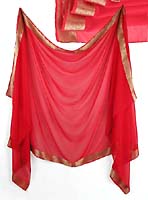Belly Dancing with the Veil
A Beginner's Guide - Zarifa
Belly dancing with a veil has it's origins in the orient and Middle East, where a veil is worn over the woman's face for discretion in public. Like any other addition to your belly dance, a veil is a prop and should be used appropriately, to enhance your expression of dance and not be the focus of the performance. Here are a few tips to get you started on dancing with a veil.
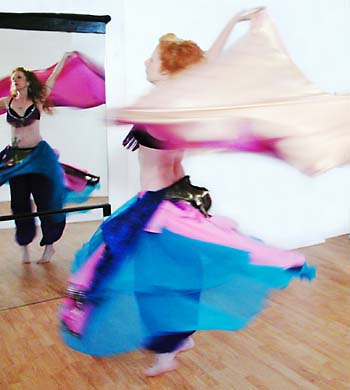
What Type of Veil?
The type of veil you incorporate into your dance should be appropriate to your body type, costume, belly dance skill level, and the speed and rhythm of your choreography. Control of the veil as you float it around you and within your dance moves is extremely important. Too short a veil for a tall dancer with long arms, or too long a veil for a shorter dancer will become difficult to work with. Large 4 yard veils can make a stunning addition to your dance, but are more expensive and require more skill and finessé to control. Smaller lightweight half circle veils, one of Zarifa's biggest sellers, are less expensive, easier to control, and perfect for both the beginning and professional belly dancer.
Choice of fabric is also important. Lightweight Chiffon veils float with less movement and are easily controlled by both beginning and advanced belly dancers. As you become more comfortable dancing with a veil, long 4 yard veils can be gracefully spun to wrap around you or flow behind you as you float across the stage, and are a beautiful addition to choreographed troupe dances. Silk veils are very beautiful and flow gracefully in the hands of an advanced dancer. Dancing with silk is like no other fabric, these veils are a little harder to handle and tend to cling to your body until understanding how the silk moves. Most professional dancers choose silk veils over other materials. Satin veils are a bit heavier and harder to control but better for fast moves, spins and double or triple veil routines where a lightweight Chiffon veil would flatten. Again, these are for the more advanced dancer.
Your First Veil Dance
Once you feel comfortable with your choice of size, select a color and fabric that enhances the expression and message you are conveying with your dance. The music, the attitude of your moves, your facial expression, and the choice of costume and colors should all contribute to your dance performance.
Begin by holding the veil correctly. Even lightweight veils can slip through your fingers; allow enough fabric to avoid dropping the corner. Hold the veil behind you with your arms out straight. Put just enough tension on the veil to keep the top edge tight (a mirror will help.) You should have at least 8 inches hanging down from your fingertips. More or less may make the veil difficult to manage, so experiment with different size veils to find the right one for you.
The key to getting the veil to cooperate is to keep the veil away from your body at all times. Veils with coins or sequins, costume adornments with complicated jewelry or coins, and other costume additions can catch on your veil and interrupt the smooth motion that makes a veil dance so impressive. Longer veils and silk veils are even more difficult in this respect; there's nothing more embarrassing than attempting a move, catching the veil on your costume and getting it stuck over your head!
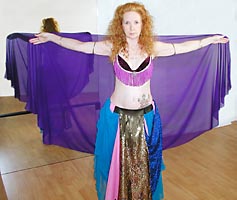
Hold the veil behind you with your arms out straight. ENLARGE
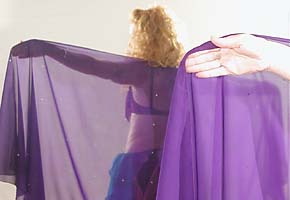
Hold at least 8" of material past your fingertips. (ENLARGE)
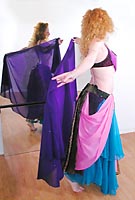
Keep the veil away from your body. (ENLARGE)
Turning the Veil (see video)
Always keep the "outside" pattern of the veil facing the audience. With some single color belly dance veils this is not as critical, but if you don't learn this skill early on, it becomes difficult when you have a patterned or a veil adorned with ornaments on one side. As you stand in the starting pose with the veil behind you, the "front" pattern of the veil should be toward your body, facing the audience. Hold left arm up over head, (holding veil tight between fingers) the right arm out to side, twist a little to the right, duck your head some if you have too while left arms goes over head. Right arm comes in toward you body making the figure eight pattern with both arms. Now the veil is in front of you with the pattern outside still facing the audience. Holding arms out to sides, left arm can be up to get ready and twist again to the right, left arm over head, right arm coming in to make the figure eight pattern again. Veil is behind you as you started with arms back out at sides. You can reverse this and do right arm up twisting to the left. Then practice switching from one way to the other. First stand still until you get the movement down with arms. Then start moving your body away from the veil while doing figure eight patterns switching the veil from forward to back. This is not as easy as it looks, practice it often!
Vary Your Moves
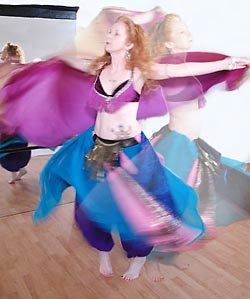
Keep arms extended and veil away from the body when spinning. ENLARGE
Keep your veil moves simple and concentrate on the dance, but try to vary the movement of the veil as much as possible, avoiding the "same old moves" with every turn. Always remember that the veil is an extension of your dance, not the focus. Keep your arms as extended as possible - this will tire your arms very quickly, so in addition to learning to dance with a veil it will require conditioning that will tone your arms and give you a good workout. Experiment with passing it over your head (don't let it touch!), to the left and right, over your arms, and always keep the "pretty side" facing the audience.
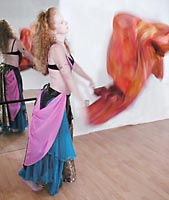
Avoid "Shaking the Laundry". ENLARGE
Avoid "Shaking Out the Laundry"
Many dancers fall into a terrible trap when dancing with a veil. A veil is meant to be incorporated into the moves of your dance; don't stop dancing and make the veil itself the focus of your performance. Often this manifests itself as an attempt at floating the veil in front of you in an up and down motion. When you catch yourself doing this, remind yourself that you're not shaking out the laundry or a throw rug, you're dancing with a veil - make it part of your dance or choreograph a way to gracefully drop the veil to one side of the stage.
Making Your Entrance
Depending on the style of music and the mood of your dance, you may not want to start on stage with the veil presented. Many dancers enter the stage with the veils tucked into their costume, then at the appropriate point in the music peel out the veil and gracefully bring it into the dance. This is particularly true for dances using multiple veils.

Step 1: To make your entrance wearing the veil, tuck veil in waistband. ENLARGE
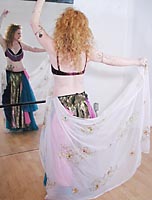
Step 1 from the Back.
ENLARGE
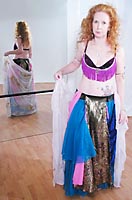
Step 2: wrap around with the adornments facing out. (ENLARGE)
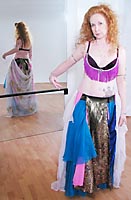
Step 3: tuck in on the other hip to make your entrance with a partial cover-up. (ENLARGE)
Belly Dance Veil Cover Up
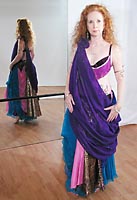
Single-veil cover-up over one shoulder. ENLARGE

Single-veil cover-up, both shoulders. ENLARGE
Traditionally dancers don't arrive at a performance or even a hafla with full costume exposed. A cover up of some kind is worn to save the dazzle of your costume for your performance. Many dancers use the veil as a "cover up" before a dance performance. Using a single veil, you can make a loose knot over one shoulder and tuck it under the strap of your costume top, with the middle of the veil draped over the opposite hip. Now take the edge of the veil just above your hip and raise it up to the opposite shoulder and tuck it under the strap of your top.
If you have two veils, you can leave the first veil draped over your hip. Tuck the knot of the second veil under the opposite shoulder and also allow it to drape over the opposite hip.
Experienced dancers make belly dancing with a veil look easy and natural but it requires lots of practice and stamina. Practice often, keeping your arms extended as much as possible, but don't do too much in one day. When you are comfortable with the basic moves of veil dancing, you can move on to longer veils, silk or satin fabrics, and advanced choreography. Stick with it, try new things to avoid boredom, use your imagination, and have fun!
Other Articles
© 2004-2021 Zarifa's Touch of Egypt, all rights reserved
- Shop Zarifa's |
- Belly Dance Costume & Accessories |
- Egyptian Decor |
- Workshops & Classes |
- Belly Dance Classes
- Affiliate Program |
- Check Out |
- Contact |
- Links |
- Business Policies |
- Home
Zarifa's Touch of Egypt · Boise, Idaho 83646 · Contact


